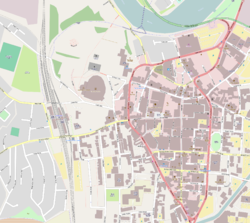Macbethad mac Findláech, nicknamed the Red King, was King of Scotland (Alba) from 1040 until his death. Little is known about Macbeth's early life, although he was the son of Findláech of Moray and may have been a grandson of Malcolm II. He became Mormaer (Earl) of Moray – a semi-autonomous province – in 1032, and was probably responsible for the death of the previous mormaer, Gille Coemgáin. He subsequently married Gille Coemgáin's widow, Gruoch, but they had no children together.

Lancaster Castle is a medieval castle and former prison in Lancaster in the English county of Lancashire. Its early history is unclear, but it may have been founded in the 11th century on the site of a Roman fort overlooking a crossing of the River Lune. In 1164 the Honour of Lancaster, including the castle, came under royal control. In 1322 and 1389 the Scots invaded England, progressing as far as Lancaster and damaging the castle. It was not to see military action again until the English Civil War. The castle was first used as a prison in 1196 although this aspect became more important during the English Civil War. The castle buildings are owned by the British sovereign as Duke of Lancaster; part of the structure is used to host sittings of the Crown Court.

The Cambridge Footlights, commonly referred to simply as Footlights, is a student sketch comedy troupe located in Cambridge, England. Footlights was founded in 1883, and is one of Britain's oldest student sketch comedy troupes. The comedy society is run by the students of Cambridge University.
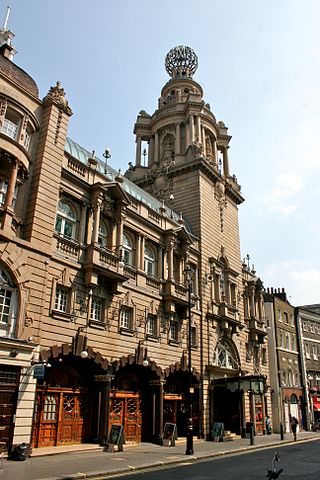
The London Coliseum is a theatre in St Martin's Lane, Westminster, built as one of London's largest and most luxurious "family" variety theatres. Opened on 24 December 1904 as the London Coliseum Theatre of Varieties, it was designed by the architect Frank Matcham for the impresario Oswald Stoll. Their ambition was to build the largest and finest music hall, described as the "people's palace of entertainment" of its age.

The Theatre Royal is a historic theatre, a Grade I listed building situated on Grey Street in Newcastle upon Tyne.

Buxton Opera House is in The Square, Buxton, Derbyshire, England. It is a 902-seat opera house that hosts the annual Buxton Festival and the International Gilbert and Sullivan Festival, among others, as well as pantomime at Christmas, musicals and other entertainments year-round. Hosting live performances until 1927, the theatre then was used mostly as a cinema until 1976. In 1979, it was refurbished and reopened as a venue for live performance.

Francis Matcham was an English architect who specialised in the design of theatres and music halls. He worked extensively in London, predominantly under Moss Empires for whom he designed the Hippodrome in 1900, Hackney Empire (1901), Coliseum (1903) and Palladium (1910). His last major commission before retirement was the Victoria Palace (1911) for the variety magnate Alfred Butt. During his 40-year career, Matcham was responsible for the design and construction of over 90 theatres and the redesign and refurbishment of a further 80 throughout the United Kingdom.

The ADC Theatre is a theatre in Cambridge, England, and also a department of the University of Cambridge. It is located in Park Street, north off Jesus Lane. The theatre is owned by the Cambridge University Amateur Dramatic Club (CUADC) but leased to the University, operating as one of the smallest departments and run by four full-time and three part-time staff. It is a producing theatre with CUADC as its resident company.
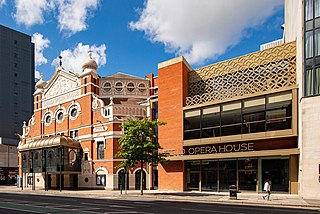
The Grand Opera House is a theatre in Belfast, Northern Ireland, designed by the most prolific theatre architect of the period, Frank Matcham. It opened on 23 December 1895. According to the Theatres Trust, the "magnificent auditorium is probably the best surviving example in the United Kingdom of the oriental style applied to theatre architecture". The auditorium was restored to its former glory, and the foyer spaces and bars were reimagined and developed as part of a £12.2 million project in 2020/2021, generously supported by the National Lottery Heritage Fund. [1]

The King's Theatre is located in Glasgow, Scotland. It was built for Howard & Wyndham Ltd under its chairman Baillie Michael Simons as a sister theatre of their Theatre Royal in the city and was designed by Frank Matcham, opening in 1904. The theatre is primarily a receiving house for touring musicals, dance, comedy and circus-type performances. The theatre also provides a prominent stage for local amateur productions. The King's Theatre also stages an annual pantomime, produced by First Family Entertainment. The theatre is currently operated by the Ambassador Theatre Group, under a lease from Glasgow City Council who own the building.
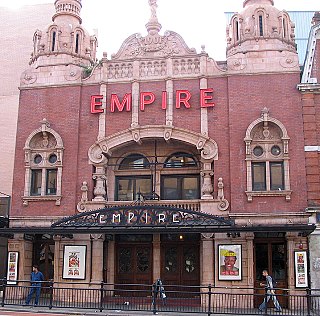
Hackney Empire is a theatre on Mare Street, in Hackney in the London Borough of Hackney. Originally designed by Frank Matcham it was built in 1901 as a music hall, and expanded in 2001. Described by The Guardian as "the most beautiful theatre in London" it is an Arts Council England National Portfolio Organisation.

Edward Graham Paley, usually known as E. G. Paley, was an English architect who practised in Lancaster, Lancashire, in the second half of the 19th century. After leaving school in 1838, he went to Lancaster to become a pupil of Edmund Sharpe, and in 1845 he joined Sharpe as a partner. Sharpe retired from the practice in 1851, leaving Paley as the sole principal. In 1868, Hubert Austin joined him as a partner, and in 1886, Paley's son, Henry, also became a partner. This partnership continued until Paley's death in 1895.

Edmund Sharpe was an English architect, architectural historian, railway engineer, and sanitary reformer. Born in Knutsford, Cheshire, he was educated first by his parents and then at schools locally and in Runcorn, Greenwich and Sedbergh. Following his graduation from Cambridge University he was awarded a travelling scholarship, enabling him to study architecture in Germany and southern France. In 1835 he established an architectural practice in Lancaster, initially working on his own. In 1845 he entered into partnership with Edward Paley, one of his pupils. Sharpe's main focus was on churches, and he was a pioneer in the use of terracotta as a structural material in church building, designing what were known as "pot" churches, the first of which was St Stephen and All Martyrs' Church, Lever Bridge.

Lancaster Priory, formally the Priory Church of St Mary, is the Church of England parish church of the city of Lancaster, Lancashire, England. It is located near Lancaster Castle and since 1953 has been designated a Grade I listed building. It is in the deanery of Lancaster, the archdeaconry of Lancaster and the Diocese of Blackburn. Its benefice is combined with that of St John and St Anne.

Skerton Bridge is a road bridge carrying the southbound lanes of the A6 road over the River Lune in Lancaster, Lancashire, England. The bridge is recorded in the National Heritage List for England as a designated Grade II* listed building and Scheduled Monument.

The English architect Frank Matcham was responsible for the design and refurbishment of around 164 buildings, mostly theatres, throughout the United Kingdom. He entered the architectural profession when he was 21, in 1874, and joined the practice of J. T. Robinson, his future father-in-law, a few years later. Matcham completed his first solo design, the Elephant and Castle theatre, in June 1879, having taken over Robinson's practice upon his death. He founded his own practice, Matcham & Co., in 1883 which experienced much prosperity. His most successful period was between 1892 and 1912, during which there was an increased demand for variety theatres which resulted in the closure and dismantlement of many music halls, which had become outdated.

Lancaster Roman Fort, also known as Wery Wall, Galacum or Calunium, is the modern name given to ruined former Roman fort atop Castle Hill in Lancaster in North West England. The first castra was founded c. 80 AD within the Roman province of Britannia.
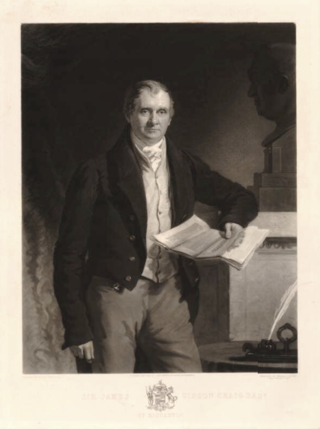
Sir James Gibson-Craig, 1st Baronet (1765–1850) was a Scottish lawyer and government official. In politics he was a Foxite Whig. In early life he was known as James Gibson of Ingleston. He was created a baronet in the Baronetage of the United Kingdom in 1831.

